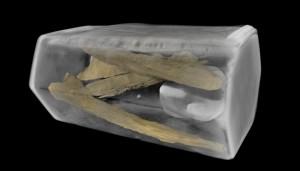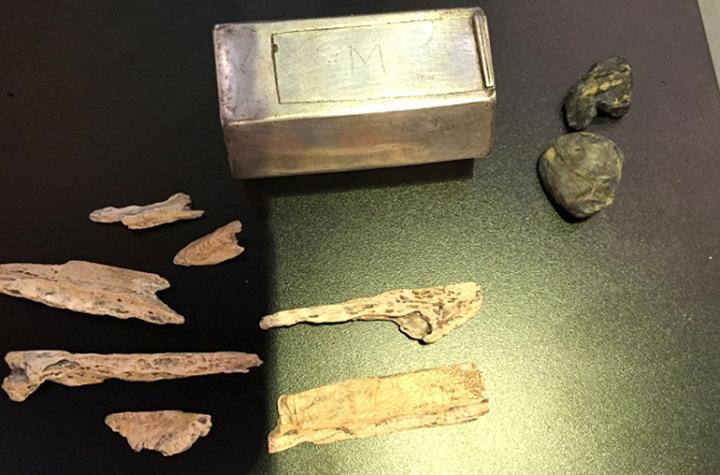 A few years back, archaeologists digging beneath a church built in 1608 found the site of four graves near Jamestown, Virginia. The vagaries of time and nature had left little but bones, the coffin nails used to seal up the dead and a pair of artifacts which proved the keys to unlocking the mystery of who those graves held.
A few years back, archaeologists digging beneath a church built in 1608 found the site of four graves near Jamestown, Virginia. The vagaries of time and nature had left little but bones, the coffin nails used to seal up the dead and a pair of artifacts which proved the keys to unlocking the mystery of who those graves held.
One, a sealed silver box, had been found atop of one of the coffins, and the other was nothing more than a few thin silver threads.
To make sense of the what the items might mean, a team from the Jamestown Rediscovery archaeological initiative needed to reveal the identities of those who had been laid to rest at the site, but to do that, they wanted to protect the artifacts from destruction.
Senior conservator of the Jamestown Rediscovery project Michael Lavin and senior staff archaeologist David Givens, contacted Mark Riccio, a research engineer and director of the Cornell Biotechnology Resource Center CT scanning facilities, to help them unravel the mystery.
Lavin, Givens and Riccio found that one scan revealed silver and silk threads – and silver spangles – locked inside a clump of dirt from the gravesite, and to their astonishment, they were able to identify the threads as portions of a captain’s sash which contained silver wires with silk and fringe.
Once they identified the composition of the fringe, they consulted paintings from the period to narrow down what sort of gentlemen might wear similar regalia.
“If you had given me the object, I could interpret the X-ray dataset but I wouldn’t have known enough about the object. But sitting with archaeologists, they could ask specific questions, and working together, we could answer those questions and identify the sash,” Riccio says.
The CT scans, taken by the Micro Photonics staff, created an image of the inside of the small silver box. The team used Cornell’s Xradia Zeiss VersaXRM-520 machine to create 3D datasets with a maximum resolution of 600 nm/voxel. With a proprietary interchangeable focusing optic, the scanner can locate and scan small sub-regions within a specimen as large as 30 cm in height and 30 cm in diameter.
 That capability makes the VersaXRM-520 unique in that most such devices typically have strict limits on the physical size of a specimen they can analyze, and the focusing optic is useful for examining specimens that are too rare – or delicate – to be sectioned and thus destroyed such as fossils, museum specimens or exotic materials such as the grave contents.
That capability makes the VersaXRM-520 unique in that most such devices typically have strict limits on the physical size of a specimen they can analyze, and the focusing optic is useful for examining specimens that are too rare – or delicate – to be sectioned and thus destroyed such as fossils, museum specimens or exotic materials such as the grave contents.
 Once a set of protocols were developed to image the contents in 3D, the box was sent to General Electric for more accurate, higher-energy CT scans.
Once a set of protocols were developed to image the contents in 3D, the box was sent to General Electric for more accurate, higher-energy CT scans.
Those images showed small bones and a lead ampulla, a container which was typically used to hold blood, oil or holy water.
By analyzing the 3D data, the staff at Micro Photonics 3D printed models of the bones and the ampulla, and that information allowed the team to determine that the bones were human and the silver box was a Catholic reliquary.
Forensic analysis of artifacts – and significant archival research – revealed that the remains of the four men found at the grave site were Captain Gabriel Archer, a critic and rival of John Smith; Captain William West, who was killed fighting Native American warriors in 1610; the Rev. Robert Hunt, the first Anglican minister at Jamestown; and Sir Ferdinando Wainman, a top officer and the first English knight buried in America.
What do you think about this archaeological project in Jamestown which used 3D scanning and printing to reveal a mystery at a grave site there? Let us know in the Jamestown Graves Mystery Solved forum thread on 3DPB.com.
– – –
As 3D technologies mature, researchers are finding novel ways to use them to aid them in their work. Archaeologists with the Jamestown Rediscovery project and technologists at Cornell University used CT scans of the inside of the small silver box and a clump of dirt to create 3D images and 3D printed replicas in order to identify the bodies of four men buried in the 1600s. You can read the whole story here: https://3dprint.com/93342/3d-scan-jamestown-graves/
https://3dprint.com/wp-content/uploads/2015/09/Cornell-BRC-Imaging-ZEISS-Xradia-Versa-520-Xray-CT.jpg
Subscribe to Our Email Newsletter
Stay up-to-date on all the latest news from the 3D printing industry and receive information and offers from third party vendors.
You May Also Like
Profiling a Construction 3D Printing Pioneer: US Army Corps of Engineers’ Megan Kreiger
The world of construction 3D printing is still so new that the true experts can probably be counted on two hands. Among them is Megan Kreiger, Portfolio Manager of Additive...
US Army Corps of Engineers Taps Lincoln Electric & Eaton for Largest 3D Printed US Civil Works Part
The Soo Locks sit on the US-Canadian border, enabling maritime travel between Lake Superior and Lake Huron, from which ships can reach the rest of the Great Lakes. Crafts carrying...
Construction 3D Printing CEO Reflects on Being Female in Construction
Natalie Wadley, CEO of ChangeMaker3D, could hear the words of her daughter sitting next to her resounding in her head. “Mum, MUM, you’ve won!” Wadley had just won the prestigious...
1Print to Commercialize 3D Printed Coastal Resilience Solutions
1Print, a company that specializes in deploying additive construction (AC) for infrastructure projects, has entered an agreement with the University of Miami (UM) to accelerate commercialization of the SEAHIVE shoreline...






























